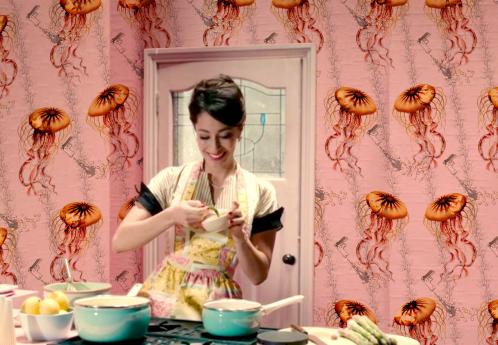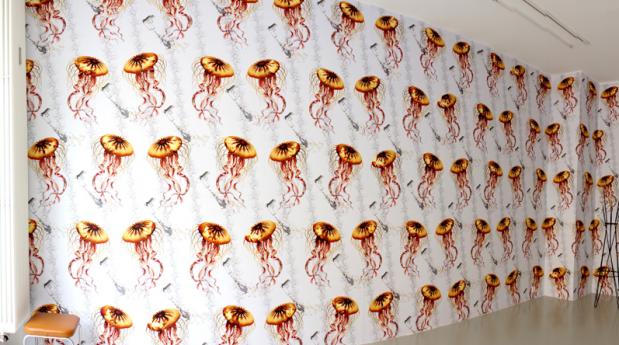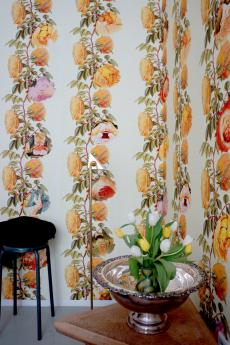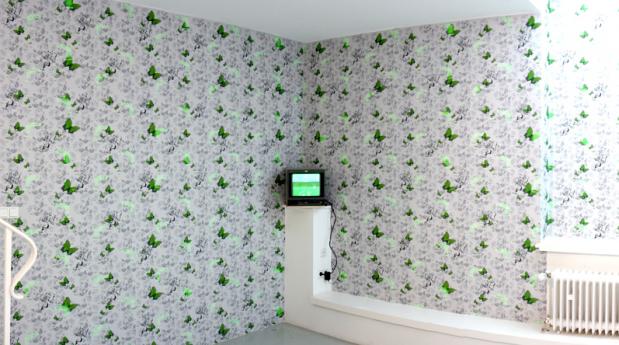Klaus vom Bruch
/
Tapete
12.04 – 16.05.2013
Tapeten werden schon seit einigen Jahrhunderten in Räumen auf Wände geklebt. Sie waren Ersatz für einen Mangel an Reisemöglichkeit. Sie sollten vor allem die Interieurs der Bourgeoisie repräsentativ und reizvoll gestalten. Flauberts Madame Bovary umgab sich mit teuren Tapeten und Stoffen, um der Enge ihrer Umgebung zu entfliehen. Überhaupt je reicher der Hausherr, desto üppiger und ausgefallener wurden die Wände. Teure Stoffe mit Goldverzierung wurden ausgelegt, der Tonwurde natürlich von Königen und Prinzen angegeben. Die zwei Weltkriege fegten diesen Wand- und Tapetenkult hinweg. Ab sofort mussten die Wände so weiß, so makellos wie unser Gewissen sein. Unsere Gedanken, unsere Blicke sollten wenn, dann nur auf der Kunst haften bleiben, nichts sollte uns vom Ernst und Verantwortung des Lebens ablenken. Ab und an wagten sich Künstler an das Medium Tapete.
So geschah es auch, dass Klaus vom Bruch dem Reiz, den uns umhüllende Intensität einer Tapete unterlag, die er ursprünglich nur für sich, für die Ironisierung seiner eigenen vier Wände entworfen hatte. In dieser Arbeit verbindet
er politische und private Gedanken durch rhythmisierte Kontrastierung disparater Topoi und Bilder. Ähnlich wie in seinen frühen Videocollagen geht er von verschiedenen politischen und gesellschaftlichen Motiven aus. Die RAF- Tapete, die Sade-Tapete und andere erfüllen alle Aspekte einer fröhlichen Ausschmückung und erscheinen im sarkastischen Spiel der Bildwechsel von RAF-Steckbriefen und einer japanischen Übersetzung von de Sades Justine, die zu Klebebildern mit Rosen und Schlafmohn dekonstruiert werden. So unterhält er uns abwechselnd ,indem er Obsession und Beruhigung gegeneinander ausspielt. Er lässt uns teilnehmen an einer Sehnsucht, die so wieder neu populär wird. Der diskrete Charme der Bourgeoisie wird stachelig und scharf vorgeführt.
The tradition to decorate rooms with wallpapers has been a common practice for several centuries. They functioned as a substitute for the lack of travel possibilities, and rendered representative and appealing bourgeois interiors. Flaubert’s Madame Bovary surrounded herself with expensive wallpapers and fabrics in order to escape her stifling environment. Generally speaking, the richer the household, the more luxurious and eccentric was its wall adornment. Expensive gold-embellished fabrics were laid out, and, needless to say, members of the aristocracy determined the respective and prevailing trends in the shading and colouring of these. Ultimately, however, it was the two world wars that annihilated this wall and wallpaper cult. From this moment onwards, walls had to be as white and unblemished as our conscience. If at all, our thoughts and views were to be directed only at art – nothing was to distract us from the severity and responsibility of life. Yet, every now and then, artists have dared to work with the medium wallpaper.
This is also why Klaus vom Bruch surrendered to the charming and allencompassing intensity wallpapers have. He initially created the wallpapers only for himself – for the ironization of his own
living environment. In this work, he combines political and private thoughts through the rhythmic process of contrasting disparate topoi and images. Similar to his early video-collages, this work, too, is derived from various political and social motives. The RAF-wallpaper, the Sade-wallpaper and the others, too, do meet all the aspects typical for a joyous decoration and yet they appear in a sarcastic play of alternating images made out of RAF warrants of apprehension and a Japanese translation of de Sade’s Justine. By additionally employing roses and opium poppies the work is further deconstructed – transformed into decals and stickers. He thus entertains us in an oscillating fashion by playing obsession and tranquilization off against each other. He allows us to participate in a longing, which, thereby, becomes popular again. The discrete charm of the bourgeoisie is acted out fiercely and sharply.
Klaus vom Bruch ( → Artist Website)
/
Biography
Philosophie an der Universität Köln
Arbeitsstipendium des Kunstfonds Studienstiftung des Deutschen Volkes
1. Deutscher Videokunstpreis Marl Silbermedaille
Videofestival Locarno/ Ascona Kritikerpreis
Videofestival Montbeliard Chargesheimerpreis der Stadt Köln
Hamburger Bahnhof, Museum für Gegenwart, Berlin
Kunstmuseum Bonn, Bonn
Museum für Neue Kunst & Medienmuseum (ZKM), Karlsruhe
Kunsthalle zu Kiel der Christian-Albrechts-Universität, Kiel
Kolumba, Köln
Museum Ludwig, Köln
Kunsthalle, Bremen
Galerie für Zeitgenössische Kunst – GfZK, Leipzig
Folkwang Museum, Essen
Lenbachhaus, München
San Francisco Museum of Modern Art
Museum of Modern Art, New York
Long Beach Museum of Modern Art
Vancouver Art Gallery, Vancouver, British Columbia
Netherlands Media Art Institute – Montevideo/Time Based Arts, Amsterdam
Stedelijk Museum, Amsterdam
Künstlerhaus Bregenz
Solo Exhibitions
"Propaganda – eine Wiederholung" / Kunstpavillon Alter Botanischer Garten, München
Institute of Contemporary Arts, London
Galerie Eigen & Art, Leipzig
Group Exhibitions
"Generation Loss" / Julia Stoschek Collection, Düsseldorf / 10 Years Julia Stoschek Collection, kuratiert von Ed Atkins
"Dr. π und die Suche nach der Quadratur des Kreises" / Bernhard Knaus Fine Art, Frankfurt am Main
"ganz konkret" / Haus Konstruktiv, Zürich
CITYSCALE 2010 Istanbul / curated by Beral Madra, Deniz, Erbas, Dr. Conny Oßwald-Hoffmann und Françoise Heitsch, Austauschprojekt von Künstlern aus Istanbul und München, Lothringer 13, Städtische Kunsthalle München, München
"Das im Entschwinden Erfasste" / Videokunst im Museum Folkwang Museum Folkwang, Essen
"Inside Installations" / Presentation Collection S.M.A.K., SMAK Gent
"Bilder in Bewegung: Künstler & Video" / Film Museum Ludwig Köln
"Changing Channels" / MUMOK Wien
"RECORD > AGAIN! - 40jahrevideokunst.de" / Teil 2 Edith-Ruß-Haus für Medienkunst, Oldenburg
"RECORD > AGAIN! - 40jahrevideokunst.de" / Teil 2 Kunsthaus Dresden
"RECORD > AGAIN! - 40jahrevideokunst.de" / Teil 2 ZKM, Karlsruhe
"Art of Two Germanys/Cold War Cultures" / Los Angeles County Museum of Art, Los Angeles
"VIDEO PERFORMANCE: Models of Self-Reflection" / Ausstellungshalle zeitgenössische Kunst Münster
"Interstitial Zones: Historical Facts, Archaeologies of the Present and Dialectics of Seeing argos" / Brüssel
"40jahrevideokunst.de" / MAMCS Strasbourg
"RÜCKBLENDE" / Neue Galerie, Graz
"True Romance" / Kunsthalle Wien
EMAF 2007 / European Media Art Festival Osnabrück
European Media Art Festival - FINAL CUT – Medienkunst und Kino / Kunsthalle Dominikanerkirche, Osnabrück
"AMERICAN VIDEO-ART" / LAZNIA - Centre for Contemporary Art, Danzig
"Photo-Trafic" / Centre pour l´image contemporaine Saint-Gervais Genève, Genf CINEFUTURO, Arte Scienza, Rom VIDEONALE Bonn
"Presentations and video-selections" / Dorottya Gallery, Budapest
" It is hard to touch the real" / Grazer Kunstverein, Graz
"40jahrevideokunst.de - Teil 1" / K21 Kunstsammlung Nordrhein-Westfalen - im Ständehaus, Düsseldorf
"40jahrevideokunst.de, Teil 1" / Revision.zkm, ZKM, Museum für Neue Kunst & Medienmuseum, Karlsruhe
"Screening War - Zur Repräsentation von Krieg in der Videokunst" / ZKM, Museum für Neue Kunst & Medienmuseum, Karlsruhe
VIDEONALE 10 - Festival zur zeitgenössischen Videokunst / Kunstmuseum Bonn
"Zur Vorstellung des Terrors: Die RAF-Ausstellung" / Kunst-Werke Berlin e.V. KW Institute for Contemporary Art, Berlin
"VIDEO - Bildsprache des 21. Jahrhunderts" / NRW-Forum Kultur und Wirtschaft, Düsseldorf
"Gelijk het leven isS.M.A.K." / Stedelijk Museum voor Actuele Kunst, Gent
"Televisions - Kunst sieht fern" / Kunsthalle Wien (Halle 1, Halle 2 im MQ), Wien
"Klaus vom Bruch/Laura Cottingham & Leslie Singer - It´s a Man´s World" / Galerie Nächst St. Stephan - Rosemarie Schwarzwälder, Wien
"Seeing Time" / The Cramlich Collection, San Francisco Museum of Modern Art
"Kunst des 20. Jahrhunderts" / Nationalgalerie, Berlin



